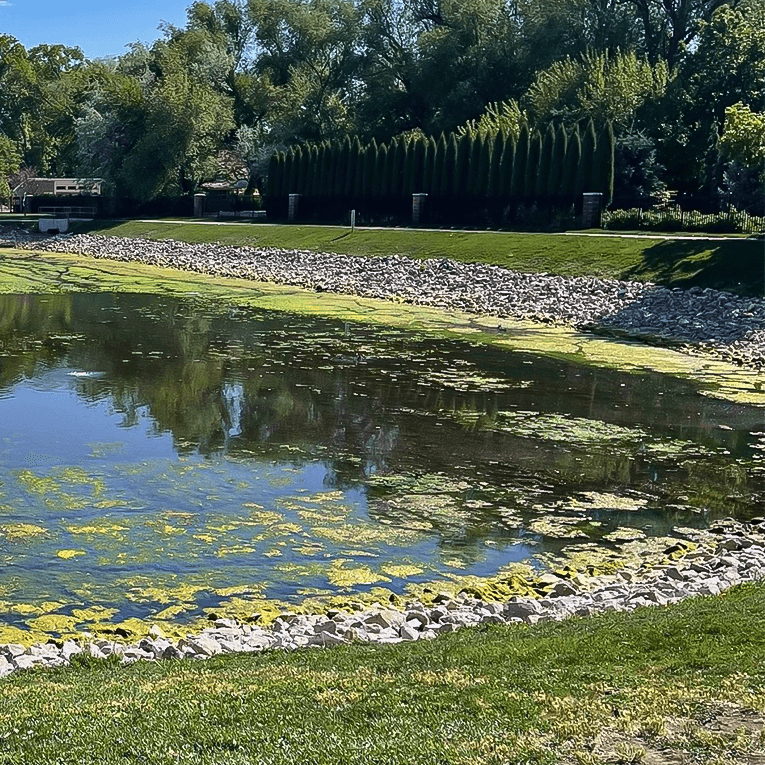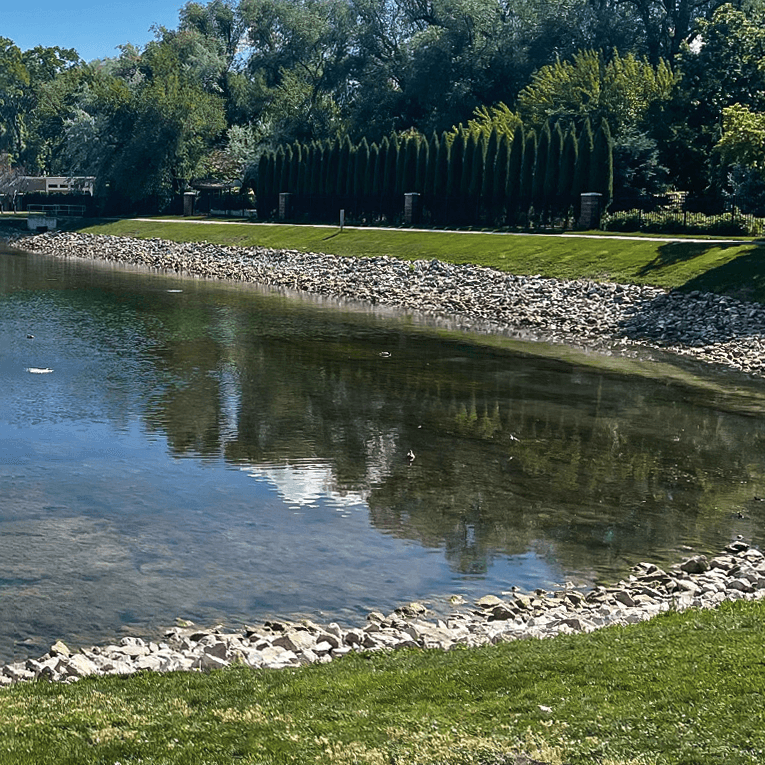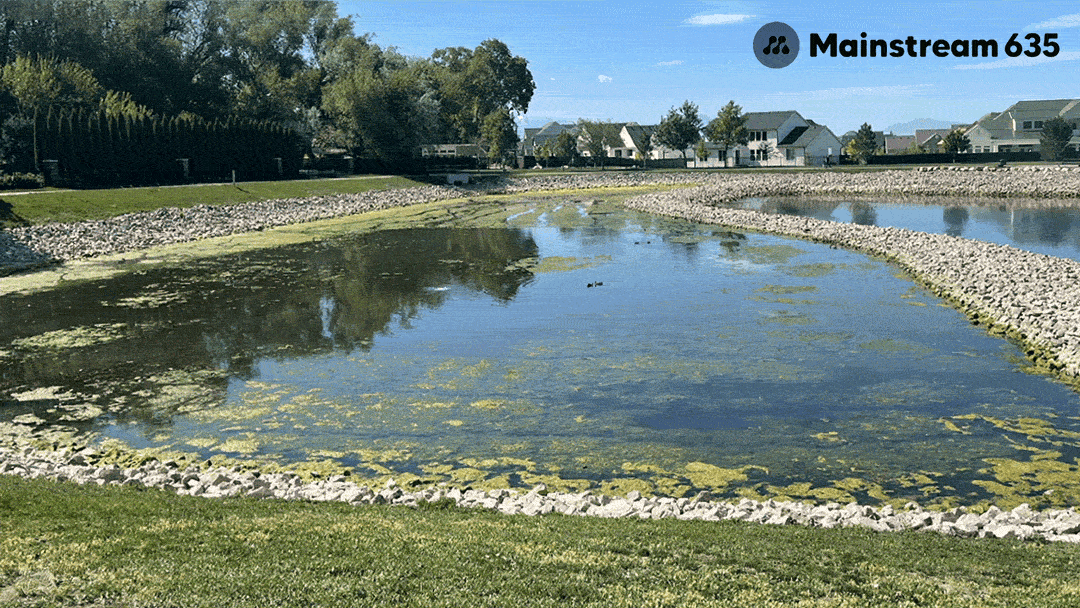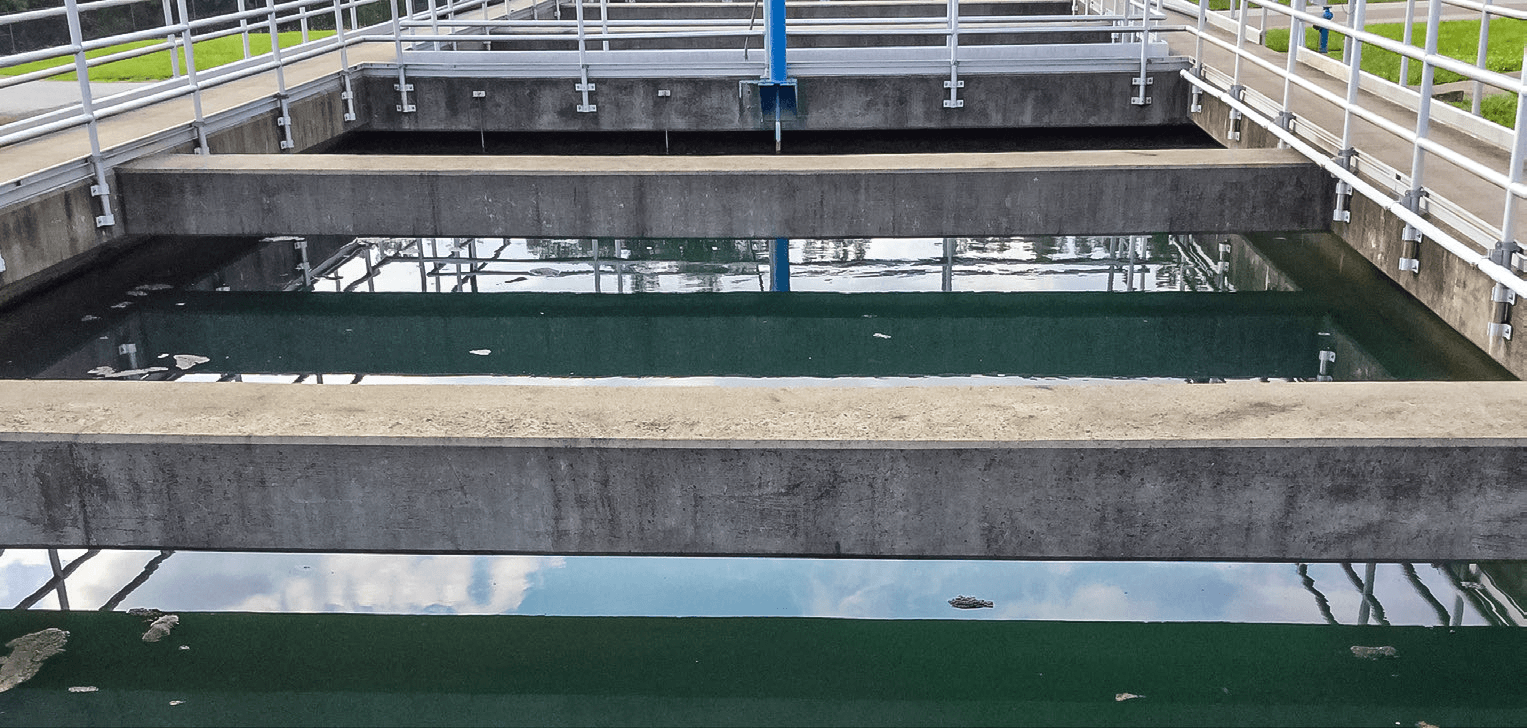Home / Solutions / Algaecides / Mainstream 635
Mainstream 635 Algaecide & Bactericide
| Price Available Upon Request
Mainstream 635 is a low pH algaecide and bactericide contains a high concentration of biologically active copper ions. Conventional methods involves treating for algae after a bloom occurs, resulting in the need for high treatment levels and damage to non-target species. Mainstream 635 allows for long-term control and will prevent blooms from occurring without buildup of copper on the bottom surface. Controlling and reducing algae and bacteria with Mainstream 635 yields crucial benefits, including:
- 1. Elimination of taste and odor problems
- 2. Reduction in THM Precursor (TOC)
- 3. Reduction or elimination of other chemical solutions
- 4. Creates no disinfection by-products
- 5. Less Maintenance
Case Study: Manila Pond
Case Study: Stanford WTP
Case Study: Kentucky WTP
Many water systems struggle when high levels of algae and organics creep into their source water. These uninvited guests wreak havoc on the treatment plant and cause difficulty allowing water systems to meet their state and federal regulations and can render recreational bodies of water unusable. Worse yet, when organics are combined with chlorine, the resulting Disinfection By-Products (DBPs) can make water quality even worse.
It’s simple: Algae & Organics + Chlorine = Increased DBPs.
A Dissolved Copper Solution with a Low pH
Mainstream 635 has a very low pH value—coming in at 0.5. The low pH helps protect the biologically active cupric ions (Cu++) and allows for self-dispersal for an even distribution. This protection allows the Cu++ to stay active longer in its soluble form. Cu++ is the only form of copper that is useful in controlling algae. Dosage rates will be dependent upon biological demand and can be adjusted based on the time of year and concentration of organics. The low pH will assist in breaking down the organic material in a wide variety of water conditions and will not precipitate out of solution.
Order Now
An algaecide for surface water
and water treatment plants
Algae and Bacteria
Mainstream 635 offers the most successful treatment to eradicate bacteria and algae. Mainstream 635 is registered with the EPA and NSF Standard 60 as a safe additive to drinking water. Due to its proprietary formulation, Mainstream 635 consistently outperforms the competition.
Rapid Mix
Do you have to turn down rapid mix due to coagulants or polymer shearing? Innova will review and recommend proper chemical products, usage, application points, and dosing to optimize performance—free of charge.
TOC at Headworks
Mainstream 635’s unique chemistry removes harmful organic carbons before they pass through your headworks. Getting your chemistry and dosages fine-tuned will result in impressive savings for your treatment plant.
Floc Basin
We will examine your floc basins and recommend the right coagulants and flocculation chemicals and dosing. This approach is more cost-effective than using legacy or commodity polymers, and we can prove it with jar testing and providing you a financial analysis of your total cost of ownership.
Disinfection By-Products
Mainstream 635 greatly reduces the need for chlorine and also reduces DBPs in a safe, compliant, and cost-effective manner. Our custom designed program will materially reduce DBPs, lower total organic carbon (TOC), and significantly reduce TTHM and HAA5 levels in your water treatment plant.
Filtration
How often do you backwash? The use of Mainstream 635 will clean your water and significantly reduce filter clogs, backwashing, and sludge buildup keeping your plant’s throughput performance at its optimal level, lowering maintenance costs, and reducing downtime.
Taste & Odor
T&O issues are one of the first indicators that something is wrong with your water treatment plant. You can rapidly remove the elements that create taste and odor problems with the correct application of Mainstream 635.
Scaling
Filtration systems do not perform properly with scaling issues. We use test methodology to demonstrate and illustrate why plant operators have to constantly replace filter media, and we will provide you with a set of recommendations and solutions to improve performance.
Backwash
Do you have algae in your backwash basins? Mainstream 635 will prevent algae from taking over your backwash basins.
Case Study: Manila Pond
Pleasant Grove, Utah
Concerned about the rapid increase of algae in a local pond, city officials reach out to ATS Innova for a solution. The Utah Fish and Game officers warned the city about the copper-sensitive trout and feared the impact on the local fish populations would be devastating. Despite this dilemma, the city decided to pursue treatment with ATS Innova and arranged for workers to clear the pond of dead fish twice a day, every day during the duration of the dosing.

Before Treatment with Mainstream

After Treatment with Mainstream
Six
Days of Treatment
100%
Algae Removal
Zero
Fish Killed
At the end of the treatment process, the pond saw the elimination of its algae problem. But they saw something else: a distinct lack of dead fish. Over the entire dosing process—in which most of, if not the entire population was expected to die—there was not a single trout death. ATS Innova continues a low-dose Mainstream 635 treatment at the pond. This maintains water clarity, and the level of copper used in this dose is far below the toxic limit for any of the aquatic life the city wants to preserve.
Case Study: Stanford Water Plant
Stanford, Kentucky
The Problem: High-level DBP Treatment Resulted in Algae Growth
The Stanford Kentucky Water Plant, which processes 1.5 million gallons per day (GPD), was experiencing high levels of trihalomethane (THM) and haloacetic acids (HAA5). To combat these dangerous DBPs, plant workers repositioned the dosing of chlorine further up the treatment process. When chlorine dosing was moved further up the system, algae growth from the adjacent water source began to grow within the plant and cause additional problems.
3.8
Parts per Million
48
Hours
DBPs
& Chlorine Reduced
After the application of Mainstream 635 at the Stanford Water Plant, there was an expected and immediate decrease in algae, but additional benefits continued to emerge. The need for chlorine was reduced, as were the levels of THM, HAA5, and other DBPs. As a result, Stanford’s water improved in both odor and taste.
Troy Carrier, the plant superintendent, requested the algae to be treated with Mainstream 635. Based on the plant results, Carrier directed the surface water next to the facility be treated as well. He reported: “Mainstream 635 eliminated the algae, reduced our demand for chlorine and improved the taste and odor of our water…We saw the same results in the lake and started treating the lake 1 or 2 times a year as needed.”
Case Study: Kentucky Water Plant
Central Kentucky
Long-plagued with algae growth in central Kentucky, this water treatment plant found finally found an effective treatment to suppress its
runaway algae problem. Though effective, the treatment was expensive. To control costs, the treatment plant tested with Mainstream 635 and was pleased to see consistent results at a 20 percent savings.
The High Costs of Effective Algae Suppression
The centrally located water plant is the sixth-largest water plant in Kentucky. It processes 7 million gallons per day (GPD) and experienced a long battle with algae within its treatment plant, especially in its sedimentation basins. During this time, they were backwashing basins monthly, wasting 1.2 million gallons of billable water with each backwash—to say nothing about the labor cost associated with each backwash. The plant’s Water Quality Director had treated the facility with a copper-based product which had disappointing results.
Eventually, a product was found that produced the long-needed results. The product was highly effective and was used for several years. Though effective, the product was expensive and left the facility with few other choices to control its algae problems.
4.5
Parts per Million
20%
in Savings
One
Yearly Backwash
In 2019, the Water Quality Director agreed to test a newly introduce the product—Mainstream 635. The treatment was introduced at the facility intake from the Kentucky River and was injected right before the static mixers. Mainstream 635 was fed into the plant at 4.5 ppm. Not only was the algae virtually gone, but the plant reduced its monthly backwashes to only one backwash a year. That provided the plant with additional profits while dramatically reducing labor costs. The facility’s Water Quality Director commented, “Mainstream 635 is equally the best copper sulfate
product we’ve used, but it was the additional 20% product savings that won over our business.”
Mainstream 635 performed equally as well as the prior, more expensive copper sulfate product, but with over 20% savings over previous methods. After the application of Mainstream 635 at the central Kentucky water plant, there was an expected and immediate decrease in algae, but additional benefits continued to emerge. The need for chlorine was reduced, as were THM, HAA5, and other DBPs. As a result, the facility’s water also improved in both odor and taste.
Let’s Talk
Algae is a real problem—and we have serious solutions. No matter your circumstance, ATS Innova will have the algaecide that will work for you. One of our water treatment experts will assess your situation and work with you to find the optimal and fastest treatment program.







